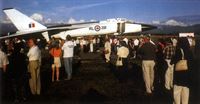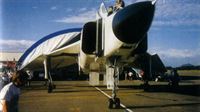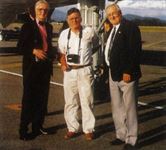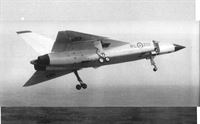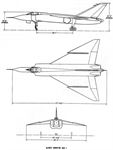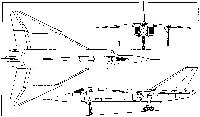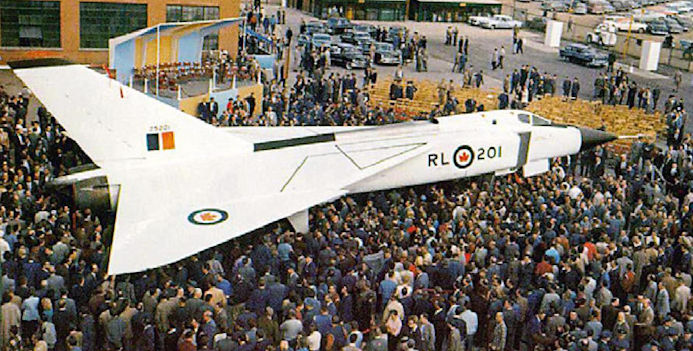
Описание
Страна : Канада
Год : 1958
Двухместный всепогодный дальний истребитель-перехватчик
Avro Canada CF-105 Arrow
Для канадской авиационной индустрии и фирмы "Avro Canada" трагическая история самолета Avro Canada CF-105 Arrow сыграла такую же роль, как для британской "British Aircraft Corporation" - судьба самолета TSR.2. Разработка этих многообещающих боевых машин была прекращена еще до запуска их в серийное производство благодаря сложившемуся к 1957 году у некоторых недальновидных политиков мнению, что ракетная техника достигла такого уровня развития, что пилотируемые самолеты более не нужны.
Первые работы по созданию нового двухместного всепогодного истребителя перехватчика для RCAF, предназначенного для замены CF-100 Canuck, начались в 1953 году. В это время канадские ВВС только приступили к формированию первых эскадрилий CF-100. Начало работ по новому сверхзвуковому перехватчику не означало разочарование в возможностях CF-100, а просто отражало тот факт, что для разработки современного истребителя и системы оружия для него требуется не менее десятилетия до принятия его на вооружение. Команда разработчиков "Avro Canada" с большим энтузиазмом взялась за решение стоящей перед ней задачи, и уже в апреле 1954 года компания приступила к постройке пяти прототипов Arrow Mk 1. Свое имя самолет получил за треугольное крыло, установленное сверху фюзеляжа. Последний имел заостренную носовую часть, а по бортам, рядом с кабиной, располагались воздухозаборники, через которые воздух поступал к двум двигателям в хвостовой части. Силовая установка Arrow Mk 1 состояла из двух ТРД Pratt & Whitney J75, но на Arrow Mk 2 уже должны были стоять двигатели собственной канадской разработки и изготовления. Речь идет о ТРД PS-13 Iroquois, созданных компанией "Orenda" - двигателестроительным подразделением "Avro Canada". Тяга каждого двигателя составляла 85,63 кН без форсажа и 115,65 кН на форсаже.
Первый прототип Arrow Mk 1 поднялся в воздух 25 марта 1958 года, и все пять самолетов этой модификации были задействованы в программе испытаний. Но 20 февраля 1959 года было принято решение о прекращении разработки истребителя. Поступил приказ уничтожить пять Arrow Mk 1, один еще не летавший Arrow Mk 2 и четыре Mk 2, находившихся в высокой степени готовности. На последующих вариантах самолета предполагалось установить вооружение из восьми ракет "воздух-воздух" средней дальности Sparrow II, размещавшихся в отсеке внутри фюзеляжа.
ТАКТИКО-ТЕХНИЧЕСКИЕ ХАРАКТЕРИСТИКИ
Avro Canada CF-105 Arrow Mk 1
Тип: двухместный всепогодный дальний истребитель-перехватчик
Силовая установка: два ТРД Pratt & Whitney J75-P-3 или -5 тягой по 82,29 кН на форсаже и 55,60 кН без форсажа
Летные характеристики: максимальная скорость на высоте 15 240 м - 2104 км/ч или М - 1,98; крейсерская скорость на высоте 10 975 м-977 км/ч; скороподъемность у земли 11887 м/мин на форсаже; потолок 15 240 м; радиус действия 660 км
Масса: пустого 22 244 кг; максимальная взлетная 31118 кг
Размеры: размах крыла 15,24 м; длина 23,72 м у первых трех самолетов и 23,41 м у последних двух (в обоих случаях без учета штанги ПВД); высота 6,48 м; площадь крыла 113,80 м2
Вооружение: не устанавливалось
- Описание
Фотографии
-
Авиация и Космонавтика 2018-07 / В.Ильин - F-4 "Фантом" II (4)
Торжественная выкатка CF-105 "Эрроу"
-
Aeroplane Monthly 1999-12 / J.Meadows - Outrageous Fortune /Avro Arrow replica/
Newly unveiled at Abbotsford in 1997, the Avro Canada CF-105 Arrow replica stands in the setting sun with snow-capped Mount Baker (USA) in the background.
-
Aeroplane Monthly 1999-12 / J.Meadows - Outrageous Fortune /Avro Arrow replica/
The Arrow emerges slowly from its temporary Abbotsford hangar at its 1997 unveiling.
-
Aeroplane Monthly 1999-12 / J.Meadows - Outrageous Fortune /Avro Arrow replica/
The Arrow’s large rectangular air intakes were revolutionary in the Fifties, as was the “notched” leading edge of the delta wing.
-
Авиация и Космонавтика 2018-07 / В.Ильин - F-4 "Фантом" II (4)
Четвертый опытный истребитель "Эрроу". Всего было построено 5 самолетов.
-
Aeroplane Monthly 1999-12 / J.Meadows - Outrageous Fortune /Avro Arrow replica/
Jack Meadows (left), with Alan Jackson (centre) and George Proulx, President of the Canadian Museum of Flight, pose in front of the Arrow.
-
Aviation Historian 3 / E.Simonsen - Project terminated
The Arrow’s low-slung nose-high attitude while on the ground giving it the appearance of a tiger on a frayed leash, the prototype, RL201, is seen here at Malton Airport, north-west of Toronto, in 1958.
-
Air Pictorial 1957-11
ARROW UNVEILED. First authorisation for a design study of the Avro CF-105 Arrow was given to the company in July 1953, and the completed aircraft was rolled out from the final-assembly hangar at Malton Airport, Toronto, on 4th October. It is a two-seat supersonic all-weather interceptor, and the prototype is powered by two Pratt & Whitney J75 turbojets. Later aircraft will have Orenda Iroquois engines. It is claimed that the Arrow is on the threshold of the heat barrier, and that studies are now under way to adapt it for even greater speeds.
-
Aviation Historian 3 / E.Simonsen - Project terminated
This photograph of the Arrow at Malton from a low angle emphasises the sheer size and clean lines of the new interceptor. The first two prototypes were fitted with a pair of Pratt & Whitney J75 engines, with a view to two far superior Orenda Iroquois powerplants being fitted to production examples.
-
Air Enthusiast 1994-12 / Talkback
Arrow, points for and against.
-
Aeroplane Monthly 1999-12 / J.Meadows - Outrageous Fortune /Avro Arrow replica/
The roll-out of the first Avro Canada Arrow at Malton, Ontario, on October 4, 1957.
-
Aeroplane Monthly 1989-06 / F.Hislop - Memories (2)
The same aircraft shortly after rollout at Malton on October 4, 1957. The first Arrow was powered by two Pratt and Whitney J75 engines.
-
Aeroplane Monthly 1989-06 / F.Hislop - Memories (2)
Jan Zurakowski lifts the prototype Avro CF-105 Arrow from the Malton, Ontario runway for its 37min maiden flight on March 25, 1958.
-
Aeroplane Monthly 1999-12 / J.Meadows - Outrageous Fortune /Avro Arrow replica/
Jan Zurakowski made the maiden flight of the prototype Arrow at Malton on March 25, 1958.
This view of the prototype Arrow shows the wing's high position and sweepback - 55° at the 25 per cent chord-line. The wing had 4° of anhedral in order to keep the undercarriage legs as short as possible. -
Мировая Авиация 42
Несмотря на высокие летные характеристики и мощное вооружение, разработка CF-105 была прекращена. Первый прототип (на снимке) успел совершить всего 25 полетов.
-
Aviation Historian 3 / E.Simonsen - Project terminated
The Arrow prototype makes a pass over Niagara Falls during its test programme. A number of the systems adopted for the aircraft proved to be innovative; the Arrow’s 4,000lb/in2 hydraulic system, for example, was highly advanced and nothing equivalent to it would be developed until the advent of Rockwell’s B-1 bomber in the 1970s.
-
Мировая Авиация 93
CF-105 - очень совершенный истребитель с незавидной судьбой. На нем устанавливался прототип современных ЭДСУ. Возможно, он был первым самолетом с автоматом загрузки, имитировавшим сопротивление руке летчика при передаче его воздействия на поверхности управления.
-
Авиация и Космонавтика 2018-07 / В.Ильин - F-4 "Фантом" II (4)
Первый опытный самолет CF-105 в полете
-
Aeroplane Monthly 1989-06 / F.Hislop - Memories (2)
The J75-powered prototype CF-105 Arrow in flight. The aircraft first exceeded Mach 1 on April 3, 1958 during a 1hr 5min flight by Zurakowski.
-
Aviation Historian 4
An unmissable bargain? Avro Canada CF-105 Arrow second prototype RL202 on a test flight with a Canadair CL-13 Sabre chase aircraft. This Arrow reached Mach 1-96, the highest speed recorded by the type.
Другие самолёты на фотографии: Canadair CL-13 Sabre - Канада - 1950
-
Air Enthusiast 1972-12 / Fighter A to Z (19)
The Avro Canada CF-105 Arrow, the photograph showing the second of five built.
-
Aeroplane Monthly 1989-06 / F.Hislop - Memories (2)
Jan Zurakowski, chief experimental pilot for Avro Aircraft Ltd. He flew the Arrow on its first flight, on March 25, 1958.
-
Aeroplane Monthly 1989-06 / F.Hislop - Memories (2)
The scene at Malton on June 11, 1958, when the Arrow prototype's port undercarriage failed to extend completely. It blew a tyre and swerved off the runway. Pilot Zurakowski was unhurt but it took four months to repair the Arrow.
-
Aeroplane Monthly 1989-06 / F.Hislop - Memories (2)
In order to simulate the CF-105’s flight characteristics large-scale free flight models were used, with rocket boosters to propel them to supersonic speeds.
-
Aviation Historian 3 / E.Simonsen - Project terminated
One of the many endlessly fascinating digital illustrations created by ERIK SIMONSEN for his Crecy book Project Terminated: Famous Military Aircraft Cancellations of the Cold War and What Might Have Been, this shows Avro Canada CF-105 Arrows Nos 213 and 204 climbing in formation with full afterburner high over Canada. Although a formation flight of the two prototypes, 201 and 202, was planned several times, it never actually took place.
-
Aviation Historian 3 / E.Simonsen - Project terminated
The author’s conceptual view of a pair of RAF Arrows, carrying droptanks, up from RAF Coltishall while serving with No 226 Operational Conversion Unit/No 145 (Shadow) Sqn circa 1968. Had the initial talks undertaken by Great Britain and Canada formulated an agreement, the type may well have been procured for RAF service.
-
Aviation Historian 3 / E.Simonsen - Project terminated
A captivating artwork of two Avro Canada Arrows performing an air combat patrol over the Canadian tundra.
-
Aviation Historian 3 / E.Simonsen - Project terminated
What might have been; the author’s depiction of a late afternoon sortie by a pair of Arrows over the western USA includes a USAF variant and an RAF Arrow painted in the colours of the Binbrook Target Facilities Flight.
-
Aviation Historian 3 / E.Simonsen - Project terminated
Another of the author’s superb digital artworks, this one depicting a hypothetical mission over the northern USA, in which a pair of USAF Convair F-106 Delta Darts formate on a visiting RCAF Arrow. The scene emphasises the difference in size between the Canadian and American interceptors.
Другие самолёты на фотографии: Convair F-106 Delta Dart - США - 1956
-
Aviation Historian 20 / G.Baughen - A Brief History of the Future
LAST OF THE DEDICATED BOMBER-KILLERS: The OR.329/F.155 contenders
ISSUED BY THE Air Ministry in mid-1954, Operational Requirement 329 outlined what the Air Staff wanted from the next generation of interceptor aircraft, and Specification F.155 detailed how this requirement should be met. The demands of F.155 included the following:
- the ability to intercept an enemy bomber flying at Mach 1+ within 20min of target contact (approx 250 miles - 400km - from the UK);
- a service ceiling of at least 60,000ft (18,000m);
- the ability to carry armament of a mixture of infra-red homing and radar-guided missiles;
- a crew of two; pilot + weapons officer/navigator.
Thus the result would have to be a rapid-climbing Mach 2+ interceptor capable of carrying at least two collision-course missiles, and which would eventually replace the English Electric P.1B Lightning. Engine manufacturers also set about developing new powerplants for this new generation of fighters, including de Havilland (Gyron/Gyron Junior) and Rolls-Royce (RB.106).
Ten designs were put forward for F.155, but none proceeded beyond the design stage, the 1957 Defence White Paper sounding the death knell of the dedicated bomber-killer. The ten were:
Avro Canada CF-105 Arrow Added to F.155 towards the end of the process, the Canadian Arrow was essentially a stopgap to cover probable delays in the Fairey Delta 3 project (see below).
Avro 729 Little appears to be known about the Avro 729; it was described variously as a single-Gyron-powered all-weather fighter and a twin-engined canard design, as seen here.
Vickers-Armstrongs (Supermarine) Type 559 This canard design with a large air intake beneath the cockpit for its twin Gyrons, one atop another, as on the P.1, was to carry a pair of Red Hebe missiles on dorsal pylons. Deemed too radical
de Havilland D.H.117 Powered by a pair of Gyron Juniors and a D.H. Spectre booster rocket in the tail, the straight-winged D.H.117 was deemed not radical enough, and certainly not enough of an advance on the P.1B Lightning.
Fairey Delta 3 Based on research undertaken with the Delta 2 (F.D.2), Fairey submitted two designs to F.155; a large twin-Gyron-engined Red Hebe-carrying version that would meet the full spec, and a smaller, less ambitious single-engined version that would be easier to develop. The large version was selected by the MoS and Air Staff.
Armstrong Whitworth AW.169 With a pair of Gyron Juniors in nacelles fitted to a razor-thin straight trapezoidal wing, the T-tailed AW.169 would carry Blue Vestas on its wingtips.
English Electric P.8A much modified and larger Lightning fitted with Red Tops on its wingtips, this was considered insufficient advance on the P.1B.
Saunders-Roe P.187 A development of the company’s SR.53 and SR.177 mixed-power concepts, the P.187 was too big from the outset.
Hawker P.1103 This was to be powered by a single Gyron, with detachable rocket boosters mounted mid-wing and Red Hebes on its wingtips.Другие самолёты на фотографии: Armstrong Whitworth A.W.167 - Великобритания - 1955Armstrong Whitworth A.W.169 - Великобритания - 1958Avro Type 730 - Великобритания - 1957De Havilland D.H.117 - Великобритания - 1958English Electric / BAC Lightning - Великобритания - 1957Fairey FD.2 - Великобритания - 1954Hawker P.1103 / P.1121 / P.1129 - Великобритания - 1957Saunders-Roe SR.177 - Великобритания - 1957Vickers-Armstrongs (Supermarine) Type 559 - Великобритания - 1955
-
Aeroplane Monthly 1999-12 / J.Meadows - Outrageous Fortune /Avro Arrow replica/
A three-view line drawing illustrates the futuristic lines of the Arrow. It was was one of the largest fighters of its time.
-
Air Enthusiast 1972-12 / Fighter A to Z (19)
The Avro Canada CF-105 Arrow.
-
Мировая Авиация 42
Avro Canada CF-105 Arrow Mk 1
-
Air Pictorial 1957-12
AVRO CF-105 ARROW. Canada's first supersonic aircraft, the CF-105 Avro Arrow, was unveiled on 4th October, at Avro Aircraft plant at Malton, Ontario, four years from the time Avro was given the authorisation to design and produce a successor to the CF-100. The Canadian Government ordered the Arrow in July 1953 and within two months the first wind tunnel tests were being run. These ranged from slow speeds to twice the speed of sound, and seventeen models of various sizes were used to obtain necessary structural and aerodynamic data. Eleven large-scale free-flight models with rocket-propelled boosters were fired at ranges in Canada and the United States between 1954 and January of this year. During 1954 when preliminary design was completed, the R.C.A.F. adopted the CF-105 designation for the aircraft. Later in 1954 power plant problems arose which required major changes in the proposed programme. The Rolls-Royce RB106 engines which were incorporated in the design would not be available in time for the CF-105, and were replaced by two Curtiss-Wright J67 engines. Then, in early 1955, the U.S. Air Force disclosed that the J67 also would be too late to meet the Avro schedule. At this point, the programme now in effect was established - the installation of Pratt & Whitney J75s, as an interim measure, and Orenda PS 13s (Iroquois) when they became available. Although the Iroquois development was well advanced, and its specifications more than met Avro's requirements, the combination of an untried engine and an untried airframe was considered not practical on an aircraft development flight test programme. One of the greatest problems, as in many of the aircraft operating over large speed ranges, was to make the air intakes efficient, and on the Arrow the boundary layer is bled off through an array of holes immediately in front of the air intakes. The air is then passed through a duct which is vented immediately below and just behind the intake. The detachable weapons bay is larger than that of the Boeing Superfortress, and will house Sperry Sparrow 2 guided missiles, which will be lowered one at a time for firing. Cameras or nuclear bombs can also be carried. The thin wing has a 60-degree sweepback, a notched, saw-tooth leading-edge and wing fences. In case of an emergency the crew of two will escape with the aid of Martin-Baker Mk. 5 ejection seats. The Arrow is expected to make its first flight some time this month.
- Фотографии

